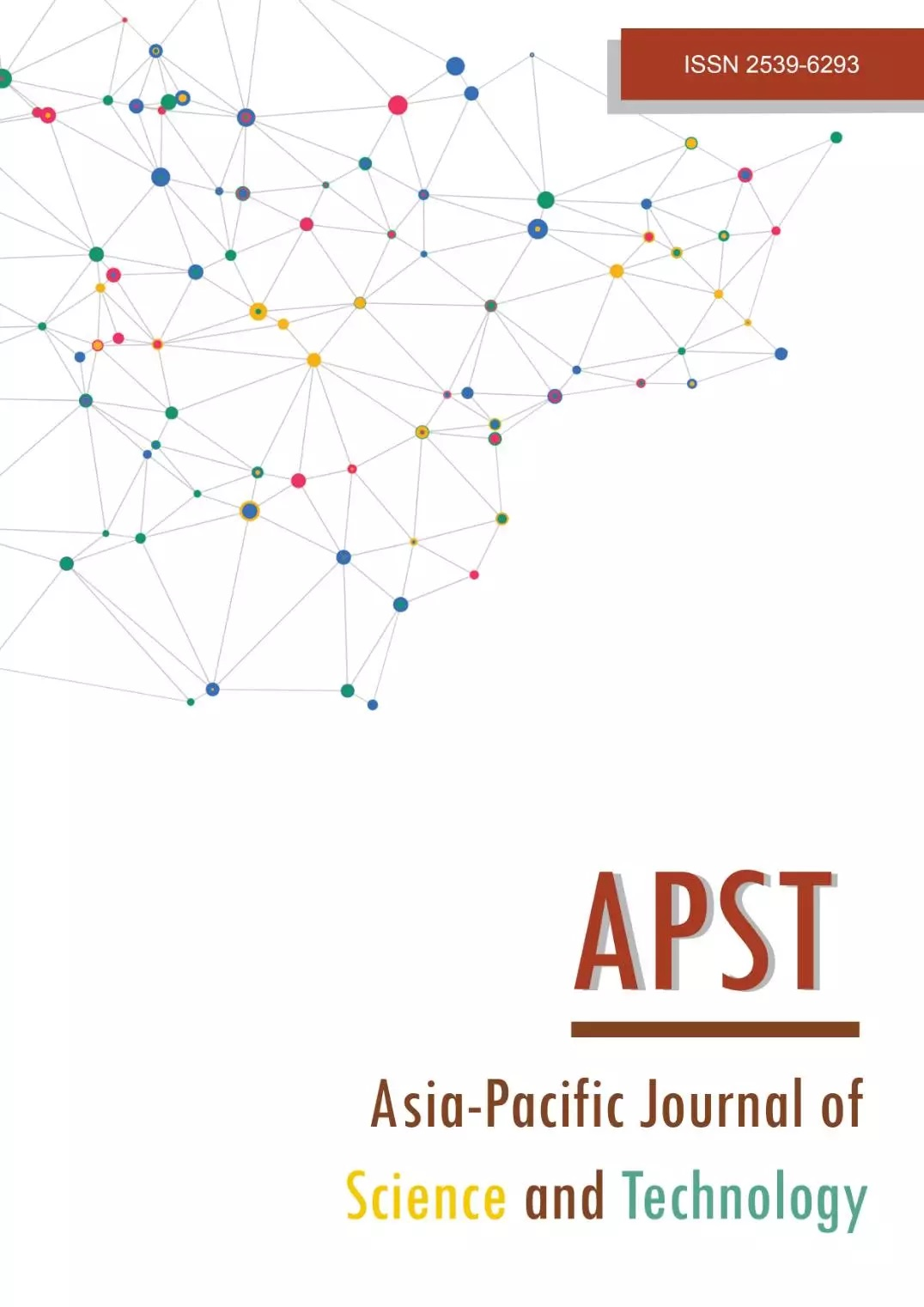A DFT study of C, SiC, Si, and SiGe colloidal quantum dots for bioimaging
Main Article Content
Abstract
Photoluminescence of colloidal nanocrystals or quantum dots has great potential in bioanalysis and diagnostic applications, as well as in optoelectronics. In this work C, SiC, Si, and SiGe colloidal quantum dots are formed based on the diamond structure or zinc blende structure with various diameters. Then, an energy-optimized structure was developed, and the electronic structure was investigated using density functional theory (DFT). The absorption coefficient of the energy spectrum of these dots is studied by employing a time-dependent density functional theory (TD-DFT) method. The calculated geometries indicated that these dots are nearly spherical. The electronic structure reveals that the highest occupied molecular orbital (HOMO) and the lowest unoccupied molecular orbital (LUMO) of energy level can be tuned by changing the quantum dot size, i.e., the energy gaps are reduced when the diameter of these dots is increased. The studied absorption energy reveals that the absorption peak is in the UV-vis range. Moreover, the absorption peak can be engineered, i.e., the absorption wavelength position is blueshifted when the size of the quantum dot is increased, both in the same materials, but in different forms and in the same form of different materials.
Article Details
References
Mao XJ, Zheng HZ, Long YJ, Du J, Hao JY, Wang LL, et al. Study on the fluorescence characteristics of carbon dots. Spectrochim Acta Part A. 2010;75:553-557.
Li QL, Yuan FL, Lei Z, Yue L, Cheng ZH. One-step synthesis of fluorescent hydroxyls-coated carbon dots with hydrothermal reaction and its application to optical sensing of metal ions. Sci China Chem. 2011;54:1342-1347.
Hu L, Sun Y, Li S, Wang X, Wang LX, Wu Y. Multifunctional carbon dots with the high quantum yield for imaging and gene delivery. Carbon. 2013;67:508-513.
Sun YP, Zhou B, Lin Y, Wang W, Fernando KAS, Pathak P, et al. Quantum-sized carbon dots for bright and colorful photoluminescence. J Am Chem Soc. 2006;128(24):7756-7757.
Dong Y, Zhou N, Lin X, Lin J, Chi Y, Chen G. Extraction of electrochemiluminescent oxidized carbon quantum dots from activated carbon. Chem Matter. 2010;22(21):5895-5899.
Dong Y, Wang R, Li H, Shao J, Chi Y, Lin X, et al. Polyamine-functionalized carbon quantum dots as fluorescent probes for selective and sensitive detection of copper ions. Anal Chem. 2012;84(14):6220-6224.
Sun YP, Wang X, Lu F, Cao L, Meziani MJ, Luo PG, et al. Doped carbon nanoparticles as a new platform for highly photoluminescent dots. J Phys Chem C. 2008;112(47):18295-18298.
Zhu J, Booker C, Li R, Zhou X, Sham TK, Sun X, et al. An electrochemical avenue to blue luminescent nanocrystals from multiwalled carbon nanotubes (MWCNTs). J Am Chem Soc. 2007;129(4):744-745.
Wang Q, Zhang H, Long Y, Zhang L, Gao M, Bai W. Microwave–hydrothermal synthesis of fluorescent carbon dots from graphite oxide. Carbon. 2011;49(9):3134-3140.
Shiohara A, Hanada S, Prabaker S, Fujioka K, Lim TH, Yamamoto K, et al. Chemical reactions on surface molecular attached to silicon quantum dot. J Am Chem Soc. 2010;132(1):248-253.
Zhao S, Liu X, Pi X, Yang D. Light-emitting diodes based on colloidal silicon quantum dots. J Semicon. 2018;39(6):061008.
Reboredo FA, Pizzagalli L, Galli G. Computational engineering of the stability and optical gaps of SiC quantum dots. Nano Letters. 2004;4(5):801-804.
Wu XK, Chenb WJ, Yu YS, Tang YL. The first principle study of the electronic structure of SixGe (1−x) alloy films. Phys Lett A. 2018;382(47):3418-3422.
Frisch MJ, Trucks GW, Schlegel HB, Scuseria GE, Robb MA, Cheeseman JR, et al. Gaussian 09, revision A.1, Gaussian, Inc.. Wallingford CT. 2009.
Marsusi F, Mirabbaszadeh K, Mansoori GA. Opto-electronic properties of adamantane and hydrogen-terminated sila-and germa-adamantane: a comparative study. Physica E Low Dimens Syst Nanostruct. 2009;41(7):1151-1156.
Nowacki W, Hedberg KW. An electron diffraction investigation of the structure of adamantane. J Am Chem Soc. 1948;70:1497-1500.
Amoureux JP, Foulon M. Comparison between structural analyses of plastic and brittle crystals. Acta Crystallogr Sect B Struct Sci. 1987;43:470-479.
Fischer J, Baumgartner J, Marschner C. Synthesis and structure of sila adamantane. Science. 2005;310: 825.
Dyall K, Taylor P, Faegri K, Partridge H. All‐electron molecular dirac-hartree-fock calculations: the group IV tetrahydrides CH4, SiH4, GeH4, SnH4, and PbH4. J Chem Phys. 1991;95:2583.
Beagley B, Monaghan JJ. Electron diffraction study of digermane. Trans Faraday Soc. 1970;66:2745.
Boyd DRJ. Infrared spectrum of trideuterosilane and the structure of the silane molecule. J Chem Phys. 1955;23(5):922.
Hinchley SL, McLachlan LJ, Robertson HE, Rankin DWH, Seppälä E. Wolf-walther du mont, steric and electronic effects on Si–Ge bond lengths: an experimental and theoretical structural study of Me2Ge(SiCl3)2 and Me3GeSiCl3. Inorganica Chim Acta. 2007;360(4):1323-1331.
Saha S, Sarkar P. Tuning the HOMO–LUMO gap of SiC quantum dots by surface functionalization. Chem Phys Lett. 2012;536:118-122.
Niaz S, Zdetsis AD, Badar MA, Hussain S, Sadiq I, Khan MA, et al. Optical properties of pure and mixed germanium and silicon quantum dots. J Chem Soc Pak 2016;38(02):211
Heinrich N, Koch W, Frenking G. On the use of Koopmans' theorem to estimate negative electron affinities. Chem Phys Lett. 1986;124(1):20-25.
Miao X, Qu D, Yang D, Nie B, Zhao Y, Fan H, et al. Synthesis of carbon dots with multiple color emission by controlled graphitization and surface functionalization. Adv Mater. 2018;30:1704740.
Zhang YX, Wu WS, Hao HL, Shen WZ. Femtosecond laser-induced size reduction and emission quantum yield enhancement of colloidal silicon nanocrystals: effect of laser ablation time. Nanotechnology. 2018; 29(36):365706.


